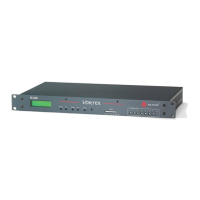settings imposed by the LO command.
If a logic pin is masked via the
LOM command, its status will still be affected by the LO command.
Example Description Status Message
F01LO*00000000000000000000
Set all logic outputs
low.
F01LO*00000000000000000000
F01LO*10101010101010101010
Set even numbered
logic output pins
low and odd
numbered logic
output pins high.
F01LO*10101010101010101010
F01LO*?
Query current state
of logic outputs
F01LO*abcdefghijklmnopqrst , where a-t are
each 0 or 1 depending on the current state of the
corresponding logic output.
8.74. LOA -- Define Behavior for Logic Output Activated State
This command is used to define the conditions under which a given logic output pin goes into the active state. By
default the logic output pins are active high. Active high is the default because it would light an LED connected to
the output when the output was in the active state. The polarity of the logic output pins can be changed with the
LOP command.
The syntax of this command allows one to use one of the boolean channel commands to determine the state of
the logic output pin. The commands that are valid for use with LOA are
AEC, AGC, AMNOMAT, CGATE, GATE,
MUTEO, MUTEI, NC, MIC, and PHANTOM. Each command must be specified using the wildcard character, *, for
the channel number.
Each character in the array string is compared to the status of the channels in the Vortex. A 1 or a 0 in the string
means that the status for the corresponding channel must match that character for the condition to be true. A
period character, ., in the string is a don't care, meaning that the condition will be true no matter what the
status for that channel is. A + or - character works as an OR function, with + corresponding to a 1 in the channel
status and - corresponding to a 0. If any + or - characters are in the string, at least one channel's status must
match for the condition to be true.
Consider the following example. In this example, we also use the
LOD command, which is just like the LOA
command except that it sets the condition for the logic output to be in the deactivated state. Normally, you must
set both the LOA and
LOD commands in order to make use of a logic output pin. In our example, we issue the
following commands:
F01LOA10,MUTEI*1100++--....
F01LOD10,MUTEI*00......00++
These two commands set the conditions for activation and deactivation of logic output 10. Under these
conditions, logic output 10 will be activated if:
● (inputs 1 and 2 are muted) AND
● (inputs 3 and 4 are unmuted) AND
● (input 5 is muted OR input 6 is muted OR input 7 is unmuted OR input 8 is unmuted)

